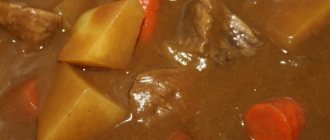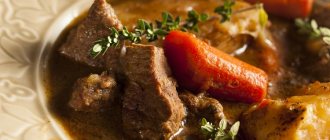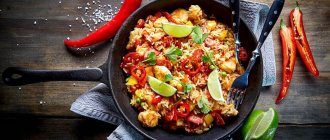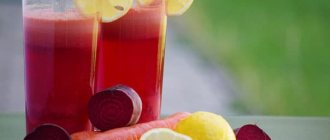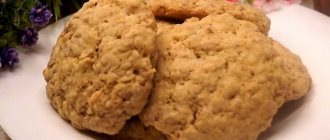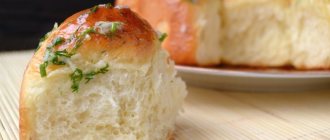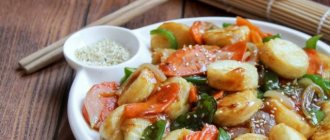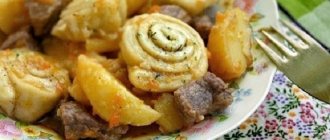What is tofu and who needs it?
We learned about tofu relatively recently - in fact, as the cuisine of Japan and China began to penetrate the country, as strange products with unusual names began to appear in stores, that’s how we found out. And what to do with this still unusual product is still unclear to many. Meanwhile, tofu not only quietly found its way onto supermarket shelves and into the menus of many restaurants, whose cuisine is not always related to Asia, but also began to be produced here in Russia. In general, it will no longer be possible to turn a blind eye to the existence of tofu; we need to understand what it is and who needs it.
I'll start from the end. So, your life will inevitably get better with tofu if you:
- If you fast (at least sometimes) - tofu is made from soybeans and is a completely lean product;
- vegetarian or vegan - being an excellent source of vegetable protein, tofu can be one of the meat substitutes;
- lover of Asian cuisines - for several centuries, tofu has been prepared not only in China and Japan, but also in Korea, Vietnam, Thailand, Malaysia and other countries where there are many wonderful recipes with tofu;
- love discovering new products and unusual tastes.
Fresh tofu
Now that only representatives of these four groups are left on the screens, let's talk about what tofu is and what it is eaten with.
We owe the appearance of tofu to soybean, a plant of the legume family, which spread to Asian countries already in the 5th century BC (and was domesticated several thousand years earlier). Soybeans are rich in protein and contain many vitamins and nutrients. But in ancient times, people did not have a way to measure the nutritional value of foods, and even more importantly, soy has a number of interesting properties that make it into many different products - butter, milk, sauces, fermented pastes and even “meat”. Or, for example, tofu.
By nature, tofu is a curd made from soy milk, although it is sometimes called soy cheese. According to legend, the first tofu was created when a paste of pounded soybeans was mixed with seawater, causing it to curdle. Today, to make tofu, soy milk is curdled using salts, acids or natural enzymes - depending on what is more accessible and traditional for the region - and then pressed into small bricks.
Based on the density of these bricks, there are several varieties of tofu: soft, also known as silken tofu, firm tofu, as well as extra-hard tofu (“dry tofu” in Chinese), which has the consistency of paneer cheese, crumbles and is sometimes cut into thin noodles for cooking. . In addition, there are several other types of tofu, which are somewhat more difficult to find here. First, marinated tofu—cubes of firm tofu that are soaked in a variety of marinades, from soybean paste to alcohol. Secondly, the so-called “stinky tofu”, a Chinese variety of tofu, which can be called an analogue of blue cheese, but only partially. This tofu is fermented in a special brine, after which it actually acquires a rather strong smell, so it is more often found in night markets and eateries than in restaurants. In addition, tofu is dried or frozen, but here we are talking more about the storage method, and not about a fundamentally different product.
Fried tofu cubes with sauce
So what is so good about tofu - of course, besides the fact that it contains high amounts of protein, vitamin B, iron, calcium and other trace elements and polyunsaturated acids? Here's what. The fact is that high-quality tofu has practically no taste of its own (of course, this does not apply to stinky tofu). Instead, tofu works like a sponge, absorbing the flavors and aroma of sauces, herbs and spices with which it is cooked, making it a versatile product. Tofu in sweet syrup is an excellent dessert, smoked tofu is a wonderful appetizer, fried tofu is a wonderful main course that lends itself to powerful Asian sauces, and in soups, stews and noodles, tofu also works as a great filler.
Even if you think you're unfamiliar with tofu, chances are you've tried it—those white cubes floating in miso soup are tofu. Well, if tofu still remains terra incognita for you, it’s time to try it: even if you don’t like tofu, your body will still receive a lot of useful substances, and you yourself will receive an invaluable experience.
Noodles
There are a great many varieties of noodles in Japan, but there are two main types: soba (buckwheat noodles) and udon (wheat flour). Japanese children love noodles just as much as their Western counterparts love pasta! Egg noodles (ramen), originally from China, are also popular in Japan.
Soba. Whole grain product, excellent source of protein, fiber and complex carbohydrates. Thin, grayish-brown noodles with a delicious nutty flavor and a soft, velvety texture. Soba is placed in soup and eaten cold, seasoned with sweet soy sauce.
Since buckwheat flour does not contain enough gluten, a little starch or wheat flour is added to the soba dough. The cheapest varieties contain quite a lot of starch (this way manufacturers reduce the cost of the finished product). This kind of soba is less tasty, and most importantly, it lacks a characteristic aroma. My advice: buy soba with a buckwheat flour content close to 100%; in extreme cases, no less than 80%.
Udon. A type of thick white wheat noodle especially loved by children. Like soba, udon is eaten both hot, in soup, and cold, with soy sauce and other seasonings.
When buying udon, pay attention to the salt content in it - it should be less (there are varieties of udon without salt at all). This is important if you intend to serve udon in a soy sauce-based broth, which itself is quite salty.
Another type of wheat noodle is popular in Japan - kishimen . Flat and wide, it is a bit like Italian fettuccine pasta.
Somen. Snow-white and very thin noodles, similar to Italian capellini pasta. They eat it mainly in the hot season. A slightly thicker variety of somen is called hiyamugi .
Ingredients:
- Classic tofu – 200 gr.
- Nori seaweed – 2-3 plates.
- Flour for batter - half a glass.
- Ground black pepper – 2-3 pinches.
- Zira (cumin), ginger – 1 pinch each.
- Salt - to taste.
- Vegetable oil – 2-3 tbsp. spoons.
- Water for batter - half a glass.
The choice of spices depends on personal preference. You can use turmeric to give the dish a golden hue. For a more spicy taste, ground red pepper or curry is suitable.
Myth 3: Tofu promotes cancer
Soy and foods like tofu have a controversial reputation because isoflavones, in addition to lowering “bad” cholesterol, affect levels of the hormonal estrogen, which is associated with breast cancer. However, according to a study from the National University of Colorado, there is no evidence that soy contributes to the development of cancer - on the contrary, much points to its opposite, extremely positive effect. And most of the benefits of tofu are due to its high isoflavone content. Obviously, in this matter, data from one source is not enough. So here are a few more. A study from the University of Hong Kong shows that women whose diets contain soy have a 48-56% lower risk of breast cancer. And the Hawaii Cancer Research Center conducted experiments and collected data for two whole years to conclude that even among postmenopausal women, tofu, tempeh and other soy products do not contribute to, and certainly cannot cause, cancer.
Let's dispel the myth about the connection between soy products and cancer? Data from scientists from cancer research centers in America, South Korea and China showed that even unfermented soy products have no connection with the development of cancerous tumors; Moreover, soy reduces the likelihood of stomach cancer by 61% in men and 59% in women.
In fact, many other studies also show that soy, and therefore tofu, reduces the risk of many types of cancer, increases survival among people with lung cancer, and reduces inflammation and the risk of hip fractures in women.
Cooking process
- Pour soy flour into a deep bowl.
- Pour cold water into it, mix thoroughly until smooth.
- Then add a liter of hot water and cook over medium heat for 10 - 15 minutes.
- Then remove the soy milk from the heat, let it cool slightly and add lemon juice.
- Mix the mixture thoroughly and strain through double folded cheesecloth.
- After all excess moisture has been removed from the bean curd, it must be placed in the prepared form and left under pressure in a cool place for three hours.
So, tofu cheese - what is it? It is a herbal product made from soybeans. It includes many useful substances, vitamins and microelements. Due to this, soy product is very popular in many countries around the world. Now you know what tofu cheese is made from and what beneficial properties this unique product has.
Tofu cheese - what is it and why do you eat it?
This product is made from soybeans. They are processed into milk, which then, thanks to additional components, curdles and turns into soft cheese. Tofu can be classified as a dietary product. Soy curd contains a minimum of calories, a lot of nutrients and vitamins, proteins and proteins.
Tofu cheese or soy curd are often used in sports nutrition. The product contains iron, calcium and vegetable fats.
Recipe for Tofu “Alya Fish”. Calorie, chemical composition and nutritional value.
Nutritional value and chemical composition of “Tofu “Alya Fish””.
The table shows the nutritional content (calories, proteins, fats, carbohydrates, vitamins and minerals) per 100 grams of edible portion.
| Nutrient | Quantity | Norm** | % of the norm in 100 g | % of the norm in 100 kcal | 100% normal |
| Calorie content | 152.6 kcal | 1684 kcal | 9.1% | 6% | 1104 g |
| Squirrels | 12.3 g | 76 g | 16.2% | 10.6% | 618 g |
| Fats | 9.8 g | 56 g | 17.5% | 11.5% | 571 g |
| Carbohydrates | 6 g | 219 g | 2.7% | 1.8% | 3650 g |
| Alimentary fiber | 0.6 g | 20 g | 3% | 2% | 3333 g |
| Water | 66.5 g | 2273 g | 2.9% | 1.9% | 3418 g |
| Ash | 1.4591 g | ~ | |||
| Vitamins | |||||
| Vitamin A, RE | 34.5 mcg | 900 mcg | 3.8% | 2.5% | 2609 g |
| Retinol | 0.03 mg | ~ | |||
| beta carotene | 0.007 mg | 5 mg | 0.1% | 0.1% | 71429 g |
| Vitamin B1, thiamine | 0.065 mg | 1.5 mg | 4.3% | 2.8% | 2308 g |
| Vitamin B2, riboflavin | 0.105 mg | 1.8 mg | 5.8% | 3.8% | 1714 g |
| Vitamin B4, choline | 36.11 mg | 500 mg | 7.2% | 4.7% | 1385 g |
| Vitamin B5, pantothenic | 0.635 mg | 5 mg | 12.7% | 8.3% | 787 g |
| Vitamin B6, pyridoxine | 0.09 mg | 2 mg | 4.5% | 2.9% | 2222 g |
| Vitamin B9, folates | 19.125 mcg | 400 mcg | 4.8% | 3.1% | 2092 g |
| Vitamin B12, cobalamin | 0.069 mcg | 3 mcg | 2.3% | 1.5% | 4348 g |
| Vitamin C, ascorbic acid | 0.49 mg | 90 mg | 0.5% | 0.3% | 18367 g |
| Vitamin D, calciferol | 0.292 mcg | 10 mcg | 2.9% | 1.9% | 3425 g |
| Vitamin E, alpha tocopherol, TE | 1.291 mg | 15 mg | 8.6% | 5.6% | 1162 g |
| Vitamin H, biotin | 2.789 mcg | 50 mcg | 5.6% | 3.7% | 1793 |
| Vitamin RR, NE | 0.9132 mg | 20 mg | 4.6% | 3% | 2190 g |
| Niacin | 0.086 mg | ~ | |||
| Macronutrients | |||||
| Potassium, K | 154.88 mg | 2500 mg | 6.2% | 4.1% | 1614 g |
| Calcium, Ca | 180.6 mg | 1000 mg | 18.1% | 11.9% | 554 g |
| Silicon, Si | 0.214 mg | 30 mg | 0.7% | 0.5% | 14019 g |
| Magnesium, Mg | 54.62 mg | 400 mg | 13.7% | 9% | 732 g |
| Sodium, Na | 341.31 mg | 1300 mg | 26.3% | 17.2% | 381 g |
| Sera, S | 27.11 mg | 1000 mg | 2.7% | 1.8% | 3689 g |
| Phosphorus, Ph | 163.9 mg | 800 mg | 20.5% | 13.4% | 488 g |
| Chlorine, Cl | 21.78 mg | 2300 mg | 0.9% | 0.6% | 10560 g |
| Microelements | |||||
| Aluminium, Al | 56.2 mcg | ~ | |||
| Bor, B | 2 mcg | ~ | |||
| Vanadium, V | 4.82 mcg | ~ | |||
| Iron, Fe | 2.206 mg | 18 mg | 12.3% | 8.1% | 816 g |
| Yod, I | 2.74 mcg | 150 mcg | 1.8% | 1.2% | 5474 g |
| Cobalt, Co | 1.413 mcg | 10 mcg | 14.1% | 9.2% | 708 g |
| Manganese, Mn | 0.782 mg | 2 mg | 39.1% | 25.6% | 256 g |
| Copper, Cu | 204.51 mcg | 1000 mcg | 20.5% | 13.4% | 489 g |
| Molybdenum, Mo | 1.466 mcg | 70 mcg | 2.1% | 1.4% | 4775 g |
| Nickel, Ni | 0.118 mcg | ~ | |||
| Tin, Sn | 0.28 mcg | ~ | |||
| Selenium, Se | 17.335 mcg | 55 mcg | 31.5% | 20.6% | 317 g |
| Titanium, Ti | 0.59 mcg | ~ | |||
| Fluorine, F | 8.48 mcg | 4000 mcg | 0.2% | 0.1% | 47170 g |
| Chromium, Cr | 0.65 mcg | 50 mcg | 1.3% | 0.9% | 7692 g |
| Zinc, Zn | 1.2684 mg | 12 mg | 10.6% | 6.9% | 946 g |
| Digestible carbohydrates | |||||
| Starch and dextrins | 3.489 g | ~ | |||
| Mono- and disaccharides (sugars) | 1 g | max 100 g | |||
| Essential amino acids | |||||
| Arginine* | 0.752 g | ~ | |||
| Valin | 0.5937 g | ~ | |||
| Histidine* | 0.3288 g | ~ | |||
| Isoleucine | 0.5623 g | ~ | |||
| Leucine | 0.8831 g | ~ | |||
| Lysine | 0.7607 g | ~ | |||
| Methionine | 0.1799 g | ~ | |||
| Methionine + Cysteine | 0.0956 g | ~ | |||
| Threonine | 0.4789 g | ~ | |||
| Tryptophan | 0.1782 g | ~ | |||
| Phenylalanine | 0.5601 g | ~ | |||
| Phenylalanine+Tyrosine | 0.15 g | ~ | |||
| Nonessential amino acids | |||||
| Alanin | 0.4942 g | ~ | |||
| Aspartic acid | 1.2399 g | ~ | |||
| Glycine | 0.436 g | ~ | |||
| Glutamic acid | 1.9184 g | ~ | |||
| Proline | 0.5781 g | ~ | |||
| Serin | 0.5825 g | ~ | |||
| Tyrosine | 0.3898 g | ~ | |||
| Cysteine | 0.1734 g | ~ | |||
| Sterols (sterols) | |||||
| Cholesterol | 75.67 mg | max 300 mg | |||
| beta sitosterol | 5.1392 mg | ~ | |||
| Saturated fatty acids | |||||
| Saturated fatty acids | 1.2 g | max 18.7 g | |||
| 14:0 Miristinovaya | 0.0053 g | ~ | |||
| 15:0 Pentadecane | 0.0013 g | ~ | |||
| 16:0 Palmitinaya | 0.4315 g | ~ | |||
| 17:0 Margarine | 0.5379 g | ~ | |||
| 18:0 Stearic | 0.2222 g | ~ | |||
| 20:0 Arakhinovaya | 0.0117 g | ~ | |||
| 22:0 Begenovaya | 0.018 g | ~ | |||
| Monounsaturated fatty acids | 5.5444 g | min 16.8 g | 33% | 21.6% | |
| 15:1 Pentadecene | 2.1365 g | ~ | |||
| 16:1 Palmitoleic | 0.0518 g | ~ | |||
| 17:1 Heptadecene | 1.0701 g | ~ | |||
| 18:1 Oleic (omega-9) | 1.152 g | ~ | |||
| 20:1 Gadoleic (omega-9) | 1.074 g | ~ | |||
| Polyunsaturated fatty acids | 2.2378 g | from 11.2 to 20.6 g | 20% | 13.1% | |
| 18:2 Linolevaya | 1.6827 g | ~ | |||
| 18:3 Linolenic | 0.008 g | ~ | |||
| 20:4 Arachidonic | 0.0133 g | ~ | |||
| Omega-6 fatty acids | 0.2 g | from 4.7 to 16.8 g | 4.3% | 2.8% |
The energy value of Tofu “Alya Fish” is 152.6 kcal.
Primary Source: Created in the application by the user. Read more.
** This table shows the average levels of vitamins and minerals for an adult. If you want to know the norms taking into account your gender, age and other factors, then use the “My Healthy Diet” application.
Similar Recipes
- Potatoes with butter, fried with onions in a frying pan
- Vegetarian shawarma with vegetables
And the fishy taste of the appetizer is given by nori seaweed, exactly the same as you use when preparing sushi and rolls.
Vegetarians who consume dairy products can use Adyghe cheese (cheese without rennet). Vegans or fasting people can replicate tofu fish. To make the cooking process easier, choose dense tofu with little water. Silken tofu is more suitable for soups, salads, sauces, cream or sushi, while the firm variety (Western or Asian) is more suitable for frying in oil or baking in the oven.
We will need:
- packaging of soy cheese (400-500 gr.)
- 1-2 sheets of nori
- 4 cloves garlic
- 1 small shallot or onion
- 1 small jalapeno pepper (can substitute crushed red pepper to taste)
- 3 tbsp. l. soy sauce
- 1 tsp. curry
- 0.5 tsp. paprika
- 4 tbsp. l. with a heap of flour
- water
- salt, pepper to taste
